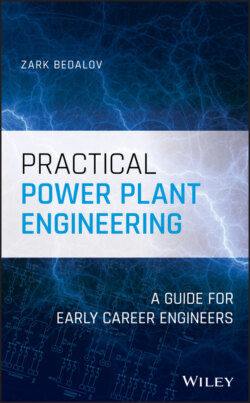Читать книгу Practical Power Plant Engineering - Zark Bedalov - Страница 54
2.5 Main Plant Substation
ОглавлениеQuestion? What is the difference between a switchyard and a substation? Is there a precise definition of one and the other? I have never heard one. In my circles, we called a facility with HV switches, circuit breakers, and transformers a substation. A switchyard was the same, but without transformers.
The main substation on this project will contain a number of major items of equipment: transformers, HV switches, HV circuit breakers, arresters, and protection panels as well as medium voltage (MV) switchgear connected to the low voltage side of the transformers. Specifications must be urgently written for the long lead items. In this substation, the transformers should be given a priority. Large transformers are long lead items, requiring 12—18 month delivery plus the procurement time. Transformers rated up to 10 MVA can be obtained within nine months. Often, large transformers may be purchased ahead of time with a provision of being cancelled if the project is not approved to proceed. To purchase the transformers, we need know: plant load, future load, voltages, and method of cooling.
Based on the projected load estimate let us assume the main transformers will be oil immersed/forced air cooled, as follows: two (2) 230 to 13.8 kV, 30/40 MVA, YNd1, ONAN/ONAF/ONAF(prov.), BIL 900 kV, 55 °C rise at 40 °C ambient. We will explain the details later.
For our plant, each transformer must carry 30/40 MVA on ONAN/ONAF/ONAF cooling. Each stage of fan cooling adds about 15% capacity to the base rating. In addition, we can specify the transformer to have a 55/65 °C temperature rise allowance. A transformer rated at 55 °C rise has about 10% spare MVA reserve over a transformer rated 65 °C rise of the same MVA rating. Obviously, a 55 °C transformer is built to a more efficient cooling design.
We choose a single ONAF cooling stage, including a provision (prov.) for adding additional stage of cooling fans if necessary in the future.
Remember, the transformer base rating is 30 MVA. This value will be used in the study calculations.
What are the designations for the transformer cooling?
ONAN: Oil Natural Air Natural → Without fans.
ONAF: Oil Natural Air Forced → With fans.
The transformers will be furnished with a conservator tank and all the standard auxiliaries. We noted the winding configuration as YNd1. Star Primary, HV Neutral solidly (effectively) grounded, Delta secondary, lagging 30° in counter clockwise (CCW) convention. The most popular winding configurations in the industry for high voltage (HV) transformers at 230 kV and above are Yd1 and Yd11.
Transformers up to 10 MVA can be ordered as “sealed tank design,” without a conservator.
The main and plant oil immersed transformers will be placed outside, next to the plant buildings in their independent vaults with oil containment basins. The walls of the vault will be fire rated (see Chapter 4 for the NFPA guidelines). The main transformers will be provided with the Deluge water mist protection system (see Chapter 22).
Furthermore, we decided that the transformers would have OnLTC in the range of ±10%. As we are 120 km away from the power plant, the voltage may not be stable. Daily 24‐hour load cycle will vary from hour to hour. The automatic tap changers will give us some form of voltage stability for the plant operation. We may also need some additional means of voltage regulation within the plant to enable us to further improve the voltage profile through power factor correction. To meet this requirement, additional capacitors and reactors may be considered (see Chapter 13).
